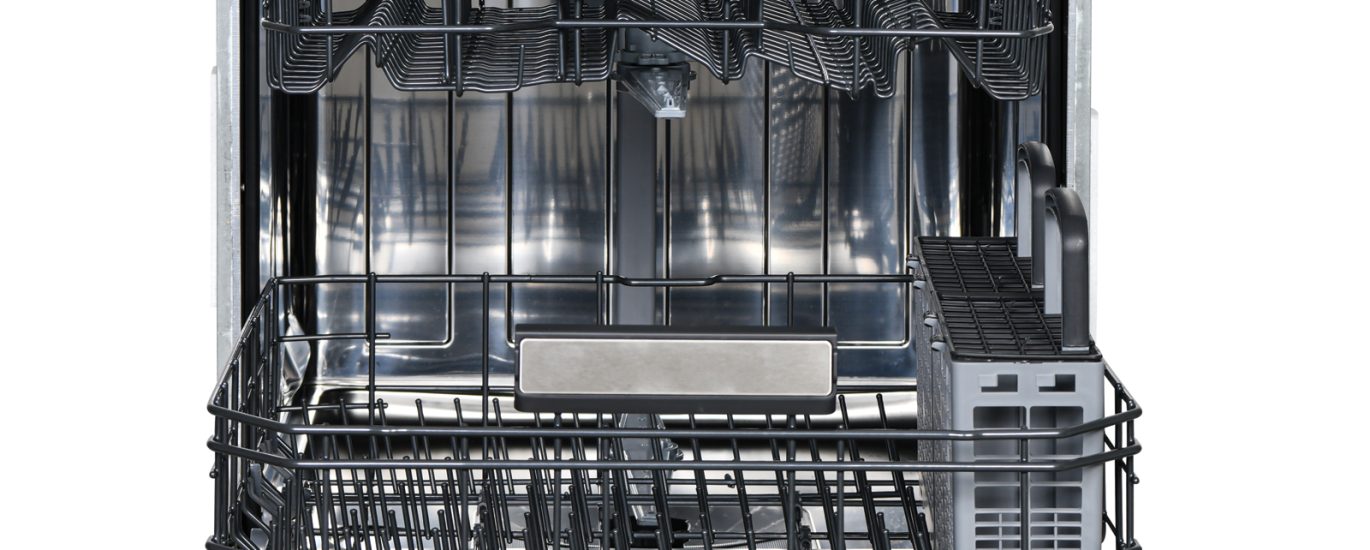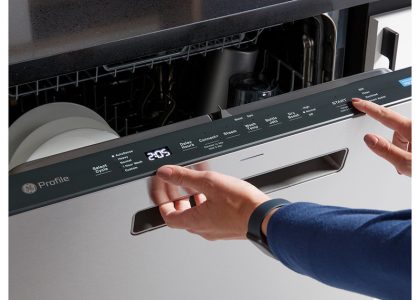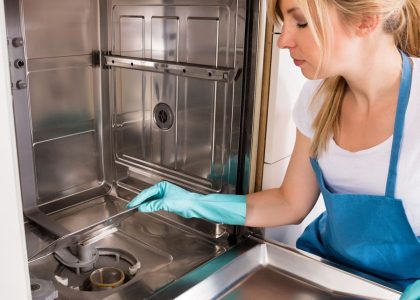Common Causes of Dishwasher Performance Issues
If your dishes come out dirty, several issues could be at play. Understanding common problems can lead to quicker solutions.
Dirty Filter and How to Clean It
A dirty filter is a main reason for dishwasher woes. To clean your filter, remove and rinse under hot water. For stubborn grime, soak in soapy water and gently scrub. Regular maintenance is key.
Clogged Spray Arm Cleaning Techniques
Spray arms need clear jets to work properly. Soak the arms in vinegar to dissolve clogs, or poke clear with a toothpick. Always rinse thoroughly after cleaning.
Dealing with a Broken Soap Dispenser
Detergent problems mean dirty dishes. Clean the dispenser with a brush and hot vinegar water. If broken, you might need to replace the spring or the door. Check the gasket too for any damage.
Enhancing Dishwasher Cleaning Effectiveness
To make sure your dishes come out sparkling, your dishwasher needs to work efficiently. Here’s how to boost its cleaning power.
The Role of Hot Water and Ensuring Proper Temperature
Adequate water temperature is vital for a dishwasher to clean well. It should be at least 120 degrees Fahrenheit. If it’s lower, you can raise your water heater setting. Check it first, to avoid scalding risks. Before starting the dishwasher, let the hot water run from the tap for a minute. This ensures the machine gets hot water from the start.
Choosing the Right Detergent and Rinse Agent
Using the correct detergent and rinse agent is crucial. Pick a high-quality product for better results. Don’t use too much, as it can cause issues. A rinse agent helps to get rid of spots and enhance drying. Again, follow the instructions for the right amount.
Addressing Hard Water with Water Softeners
Hard water can leave residue and affect your dishwasher’s performance. If you have hard water, a water softener can help. It will reduce mineral deposits and keep your dishes and the dishwasher clean.
Maintenance Tips for Optimal Dishwasher Function
To keep your dishwasher in top condition, regular upkeep is essential. Here’s a rundown of maintenance must-dos.
Routine Cleaning of the Dishwasher Interior
Build-up inside your dishwasher can cause problems. To clean, run an empty load with white vinegar. This removes grease and scale. Do this monthly for best results.
Checking and Cleaning the Inlet Valve
A faulty inlet valve hampers water flow, affecting cleaning. Listen for unusual noises that signal valve issues. Refer to your manual to locate and inspect the valve. If dirty, clean it. If broken, replace it.
Regular Filter and Spray Arm Maintenance
A clogged filter or spray arm can stop your dishwasher from cleaning properly. Every few weeks, remove the filter and spray arms. Wash them with hot water. Clear spray arm holes with a toothpick. Reassemble once everything is clean. This keeps water flowing and dishes clean.
Dishwasher Loading Strategies for Cleaner Dishes
Loading your dishwasher correctly is key to getting your dishes clean. Follow these tips to prevent blockages and ensure everything gets a thorough wash.
Proper Stacking and Spacing Techniques
Stack your dishes with space between them. This lets water and detergent reach every surface. Tilt bowls and cups so water doesn?t pool. Place larger items at the back and sides, and keep smaller items in the center.
Avoiding Overloading to Ensure Water Circulation
Don’t pack dishes too tightly. Too many dishes can block water flow and decrease cleaning power. Load just enough to allow the spray arms to rotate freely and water to circulate effectively.
Placement Tips for Different Types of Dishes
Put glasses and lighter items on the top rack. Secure them so they don’t flip. Place pots and pans on the bottom rack facing downward. Rest utensils in the cutlery basket with handles down, but keep sharp knives pointing up to prevent injury.
Troubleshooting Water-Related Issues
Water pressure is crucial for your dishwasher to function correctly. Here are some tips to address water pressure and inlet valve issues.
Addressing Low Water Pressure and Volume
Low water pressure can prevent your dishwasher from cleaning dishes properly. If the water pressure is too weak, it may not be able to spray and reach all dishes. Check the water pressure in your home by turning on faucets. If it’s low throughout the house, you may have an issue with the main supply. Contact a plumber if needed. For dishwashers, clean the valves and hoses regularly to prevent blockage and maintain pressure.
Ensuring the Inlet Valve Works Correctly
The inlet valve controls the water flow to your dishwasher. A faulty valve can lead to no water or too little water during cycles. Listen for odd noises or look for leaks as signs of valve issues. To check the inlet valve, turn off the dishwasher’s power and water supply. Then, locate the valve, often found behind the kickplate. Consult your manual for specific instructions. If the valve is dirty, clean it with care. If it’s damaged, it must be replaced. For complex valve issues, call a professional repair service for help.
When to Seek Professional Help
Sometimes, despite all efforts to troubleshoot and maintain your dishwasher, persistent or complex issues may arise. When basic cleaning and maintenance don’t resolve the problems, it could signify that more serious repairs are needed. Identifying when these complications are beyond your ability to fix is crucial to the longevity of your appliance.
Identifying Complex Problems
You might need expert assistance if you encounter problems like water not heating up, strange noises, or error messages that you can’t decipher. If the dishwasher repeatedly leaves dishes dirty or if you spot water leakage, these are additional red flags. Electrical issues or anything that feels beyond the scope of regular maintenance also warrant professional assessment.
Contacting Repair Services for Persistent Issues
If you’re facing ongoing difficulties with your dishwasher and the solutions suggested have not helped, it’s important to reach out to a qualified repair service. They have the expertise and specific tools to diagnose and fix complex problems efficiently. Timing is key—contacting them early can prevent further damage and potentially more costly repairs. Remember, when in doubt about any aspect of your dishwasher’s functioning, it’s best to consult with the pros who can offer the proper support and ensure your dishwasher returns to its peak cleaning performance.
Dishwasher Issues – Common Issues
-
Check the water temperature: Make sure your dishwasher is heating the water to the correct temperature. If the water is not hot enough, it may not be able to effectively clean your dishes.
- Clean the filter: The filter in your dishwasher can build up with food particles and debris, leading to poor cleaning performance. Remove the filter and clean it thoroughly to ensure proper water flow.
- Use the right detergent: Using the wrong type or amount of detergent can result in dishes not being properly cleaned. Make sure you are using a high-quality dishwasher detergent and follow the manufacturer’s recommendations for the correct amount to use.
- Load dishes properly: Overloading the dishwasher or placing items in a way that blocks the spray arms can prevent dishes from being cleaned effectively. Make sure dishes are arranged in a way that allows water to reach all surfaces.
- Run a cleaning cycle: Some dishwashers have a cleaning cycle option that can help remove buildup and debris from the interior of the dishwasher. Running a cleaning cycle periodically can help maintain the performance of your dishwasher.
- Check the spray arms: If the spray arms in your dishwasher are clogged or damaged, they may not be able to effectively distribute water to clean your dishes. Inspect the spray arms and clean or replace them as needed.
By addressing these common issues, you can help resolve cleaning troubles in your dishwasher and ensure that your dishes come out sparkling clean after each wash. If you continue to experience problems with your dishwasher’s cleaning performance, it may be necessary to seek professional repair or maintenance services.








